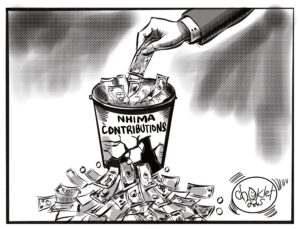In the past few weeks, the youths of Zambia have been making demands to be part of the national governance and development process. Salient among the demands have been high unemployment rate and the consequent right to be heard through freedom of speech. This has coerced the relevant authorities to lend a listening ear. One prominent sector that comes out from relevant line ministries is the youth being encouraged to start cooperatives and venture into livestock farming. Some groups have already started receiving small livestock such as chickens and goats. Livestock can indeed play a significant role in employment creation and lead to youth empowerment and development. However, the way in which this is being done currently may not achieve the desired results. A critical and close look at the livestock industry elucidates lack of organisational models and non-existent institutional innovations. In this article, I will endeavour to discuss a systematic way through which in my informed opinion, the livestock sector can potentially play a significant role in youth empowerment. I will start with giving examples of flaws in the way we are currently traditionally implementing this agenda, and end by briefly explaining my proposed sustainable and systematic way in which the livestock sector can play a potential role for Youth Empowerment in Zambia.
Perhaps before getting into details, let me introduce myself because from the onset of writing articles, chiefly cantered on livestock subsector and how the government may harness it to contribute to livelihoods and GDP effectively, I have gotten many questions on who I am and what my agenda is. Well, I am an animal health economist with research interests in livestock economics, systems thinking and participatory epidemiology in animal health. My main agenda is to play a role in the transformation of the livestock sector through research is livestock economics, participatory strategic planning, foresight modelling, and livestock development policy advocacy. In short, the underlying premise and public discourse of my pilgrim is to offer foresight and advice to would-be information end-users. A lot of research is being conducted but ends only in peer-reviewed journals that end-users do not have access to. My thrust is to share with my fellow citizenry some of this information in the sector where I am well versed. Why advise our nation? Well, Historians always remind us that if we do not look back at history, we shall repeat the same mistakes our ancestors made. For example, advisory systems in Ireland and the United Kingdom during the middle of the nineteenth century helped Irish potato farmers diversify into different food crops during the potato famine in Ireland (1845–1851). That is my role! Period.
I have persistently asked, and I will still ask again; “Do we have a livestock policy? Alternatively, in simple terms, what is our primary national goal with regards to livestock? Are livestock production strategies in place? What is really Zambia’s livestock agenda? Do we have a livestock production, research, disease control, and market agenda? Do we have livestock genetic improvement agendas? What are Zambia’s livestock value addition strategies? Do we have livestock expansion programs? Does Zambia after more than 50 years of Independence have an improved locally adapted Dairy or Beef breed before we even ask about pigs or goats? Do we have incremental stakeholder advisory indabas on livestock? If the answer to these many questions is NO: what are we still doing and who is to blame?
Back to the objective of this article, let me start with describing the flaws in the way we are currently distributing livestock and livestock equipment such as egg incubators to youth and women groups in the name of cooperatives. We are now using the traditional system, what the Bembas call “Tubatwailie bakayiwonawile abene”, a reversal way of giving the groups livestock and thinking they will learn later while keeping the animals. In its current form, you can provide livestock to the youths but come next year; there will be no livestock because they either died, stolen or eaten due to lack of sustainable systems in place. We have seen Governmental and Non Governmental Organisations give livestock to farmer groups, and almost all disappear a few months or years later. For instance, one NGO gave dairy cattle (Jersey breed) worth K12, 000 each (then) to cooperatives in one of the provinces, but more than half died of East Coast Fever (going by local names of Denkete or Chigodola) because of poor or lack of tick management. They assumed that these exotic breeds are also managed like local breeds which survive by the grace of God. Similarly, we have seen egg incubators being given to cooperatives, but one year down the line, there is no chicken to show because either the incubator could not work due to unstable power supply consequently spoiling the eggs or indeed the hatched chicks could not survive due to poor chick management. The other issue is the widely held perception that such initiatives mostly favour youths aligned to the party in government. Whether a mere perception or not, there is a need for practical political will to demystify it. Some groups are given livestock, but they have no land on which to rare them. How can we provide livestock to someone in Kabwata without land and expect the chickens and goats to multiply after being fed on crumbs of plain nsima? Are we merely giving them livestock for them to slaughter and eat? Is there a well-planned and thought through the process before distributing livestock to be reared on paved stone environments? In my opinion, this is not livestock development? There is a need to develop viable and sustainable systems for livestock development using the 6 million youths, and women groups whom I believe are leverage for transforming the livestock sector. How can this be done?
We need to start by developing a full package for any beneficiaries of livestock empowerment project, be it youths, women groups, schools, minority and disadvantaged groups. We need to come up with viable models that take into account the number of livestock commiserate with a feasible business intention, e.g. for pigs how many sows (females) and boars (males) does each group need to run a viable enterprise? Then, before we give these groups livestock, let us give them some basic coordinated training in livestock production and health management in conjunction with universities/colleges, line ministries such as Fisheries and Livestock, Commerce, Trade and Industry, and other stakeholders. I am not talking about the several knee-jerk and uncoordinated pieces of training, which are currently being conducted by every Jim and Jack among small-scale farmers. After giving them livestock, there should be an attending animal scientist and veterinarian in charge of production and animal health just like we have extension officers for conservation agriculture and other programs. Private practitioners, government and universities have these experts who can be conveniently linked to cooperatives that can work closely with these groups until such a time when the groups can become independent with a proper exit strategy. The animal scientist and veterinarians during the intervention phase will give quarterly reports to the line ministries implementing such development projects, e.g. Fisheries and Livestock, and Youth and Sports, Community Development. In three simple words, this is; “planning, implementation, and evaluation”, something that is not happening currently with a number of either government or NGO implemented projects. It should be understood from the onset that Livestock rearing is a business; as such, a risk management plan must be put in place. This calls for integrating livestock insurance in the business model. Viable commercial and emergent (weekend) farmers in certain areas must be linked to these systems for farmers to make exchange visits and practical training on livestock production and management. Government breeding (rather multiplication) centres must be connected in the same model. Donors and cooperating partners would definitely want to support a viable and sustainable livestock development system. It is such a system that deserves egg incubators from the Presidential Economic Empowerment Funds. These farmer groups will be then connected to the market through chain stores. It is these primary groups that we can further pool to form a secondary and tertiary groups that can then access regional and international markets through a systematic way. Only then will we be able to trace and identify livestock with a paper trail at every level of transaction. Currently, livestock like chickens and goats will change hands ten times before reaching the consumer without a paper trail at every transaction. This does not give confidence to the consumer that the meat they are eating has been appropriately raised with sound animal health systems. Additionally, this long farm-to-fork chain serves to exploit the producer and the consumer. This, in my opinion, is what I call livestock development for this country. By empowering the youth sustainably and systematically, we will be providing employment, national food and nutrition security, and incomes, hence building household economic resilience.
Now to do this, we need to have a clear livestock policy, with production strategies that will systematically feed into this system with clear budget lines. Any strategic plan that we are developing in a top-down process without speaking to viable and sustainable systems may not achieve our desired goal to use this sector for youth empowerment and development. We shall continue saying the livestock sector is a game-changer and has potential drive the export diversification agenda but without achieving or realising that potential. The best way for the government to avail the youth’s constitutional right to freedom of speech being sought is to empower the youths in the manner I have outlined – sustainable, systematic and impartial. When this is done, the majority of the demonstrations the youth will be involved in are ones of their successes to their peers, and such demonstrations do not need the almost always invariably elusive police permits.
The author is Senior Lecturer of Livestock/Animal Health Economics at the University of Zambia, School of Veterinary Medicine. Email: [email protected], Mobile: +260977717258

























One Response
Very well said , but when will it be implemented?